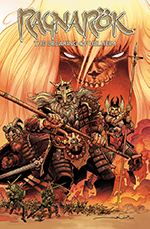
Ragnarök: The Breaking of Helheim (January 2021)
Written and drawn by Walter Simonson ’68
For the past seven years comic book legend Walter Simonson ’68 has focused almost exclusively on a single long-form epic fantasy story, which has been building into a defining work of his career. Now on its third volume, Ragnarök finds Simonson delving deeply into his lifelong fascination with Norse mythology, which he first explored extensively in his renowned run on Marvel Comics’ Thor in the 1980s. Outside the constraints of a corporate-owned superhero universe, Ragnarök allows Simonson to tell big, consequential stories about his version of the thunder god, and to go all out on mythology geekery.
Ragnarök is set hundreds of years after the eponymous event, a defining moment when the Norse gods face their final battle against their enemies, who are led by the serpent Jormungandr. In Simonson’s telling, Thor was conspicuously absent during this great conflict, held captive in a sort of suspended animation inside a fortress on the edge of the world. At the beginning of the series’ first volume, Thor is inadvertently revived by a Black Elf assassin sent to kill him, and he awakens to a world that is very different from the one he left behind.
Caught somewhere between life and death, Simonson’s version of Thor looks nothing like the character published by Marvel (nor like Chris Hemsworth): his long hair has turned white, his face is skeletal and missing its lower jaw, and his armor has faded to subdued silver and blue, rather than the bright reds and yellows of the Marvel character’s costume. This Thor is bitter and lonely, nearly all of his family and friends long dead.
Thor’s grim outlook is leavened by a mordant sense of humor, and in the first two volumes, his single-minded purpose is balanced by the Black Elf characters Regn and Drifa, husband and daughter of the assassin who failed to kill Thor. These more grounded characters (as grounded as blue-skinned elves with magical powers can be) keep the series from feeling too dour or aloof, and one of the few disappointments in Volume 3, The Breaking of Helheim, is that their story is relegated to only a handful of pages in brief interludes.
Ragnarök is a dark story, but it’s also a rousing saga that features some of the most dynamic, gorgeous art that Simonson has ever created. He conveys the scope and grandeur of Thor’s quest in awe-inspiring splash pages and double-page spreads, and he uses intricate panel design for interactions among various mythical figures. In The Breaking of Helheim, Thor heads to the underworld to confront the goddess Hel, whom Simonson reimagines as an imposing villain to rival any that he ever drew at Marvel or DC.
Simonson is an old-school superhero artist at heart, and in Ragnarök he proves adept at the dying art of the comic-book sound effect, with exclamations like “Karingnng!” and “Sploacckp!” and “Thrakkakraaoooom!” punctuating the action sequences. It’s that combination of vintage adventure storytelling and wonky mythology research that makes Ragnarök a uniquely Simonsonian project, and one that could unfold for many volumes to come.
Bell is a Las Vegas-based critic and frequent reviewer for Amherst.
